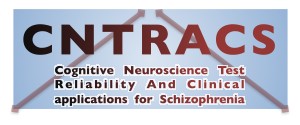The Cognitive Neuroscience Test Reliability And Clinical applications for Schizophrenia (CNTRaCS) Consortium was formed to optimize and provide psychometric data on theoretically motivated tasks from cognitive neuroscience so that they can be used as measures of treatment effects in translational research seeking to improve cognition and clinical and functional outcomes in schizophrenia. This set of projects developed as an outgrowth of the CNTRICS initiative and in response to RFA-MH-08-090, titled "Adapting Basic Cognitive Measures for Clinical Assessment of Schizophrenia." We brought together a collaborative "translation" team that represents significant expertise from the many fields necessary for the success of this endeavor, including both basic and clinical cognitive neuroscientists, psychometricians, and clinical trials specialists. Across all phases of CNTRaCS, our aims have been to validate (in both individuals with schizophrenia and comparison participants) optimized versions of the paradigms that assess our four constructs of interest, and to examine the relationship of task performance to clinical and functional outcomes in schizophrenia. By optimization, we mean examining modifications on already validated paradigms that are designed to: 1) minimize task length; 2) simplify task administration across multiple sites; 3) maximize sensitivity and selectivity in assessing the specific cognitive mechanisms of interest; and 4) enhance reliability and minimize floor and ceiling effects. In addition, the resulting tasks will be tolerable to patients, practical in duration, and freely available for download to clinical investigators. By validation, we mean ensuring that such optimizations designed to enhance the psychometric properties of the task do not alter its construct validity. The first phase of CNTRaCS resulted in four tasks with proven psychometric characteristics as well as excellent construct validity.
The domains/tasks in the first phase of CNTRaCS were:
- Goal Maintenance: The Dot Probe Expectancy Task (DPX), a variation on the Expectancy AX-CPT
- Relational Encoding and Retrieval: The Relational and Item Specific Encoding Task (RISE)
- Gain Control: The Contrast-Contrast Effect Task (CCE)
- Visual Integration: The Jitter Orientation Visual Integration Task (JOVI)
In the second phase of CNTRaCS, we expanded to transdiagnostic populations that include schizophrenia, schizoaffective disorder, bipolar disorder and major depression, and conducted the same type of construct validation and psychometric analysis for new tasks, adding in constructs of working memory and both explicit and implicit reinforcement learning.
The domains/tasks validated in the second phase of CNTRaCS were:
- Working Memory: Change Localization
- Working Memory: Change Detection
- Working Memory: Running Span
- Explicit Reinforcement Learning: Explicit Probabilistic Reinforcement Learning
- Explicit Reinforcement Learning: Reversal Learning
- Implicit Reinforcement Learning: Implicit Probabilistic Reinforcement Learning
The domains in the third phase of CNTRaCS are:
- Working Memory: Change Detection
- Episodic Memory
- Visual Perception
- Effort Based Decision Making
- Interactions between Working Memory and Reinforcement Learning
